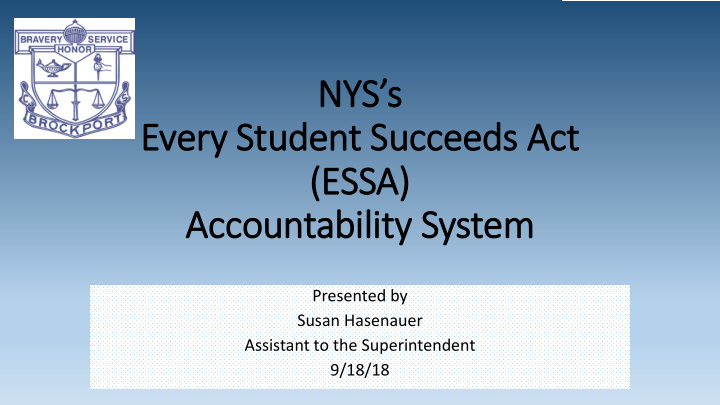



NYS’s ’s Ever ery S Studen ent Succeed eds Act (ESSA) Accountability S y System Presented by Susan Hasenauer Assistant to the Superintendent 9/18/18
What i is you our level o of knowled edge a e abou out NY NYS’ S’s ESSA A plan?
I W Will ill…… • Have an understanding of the State’s Accountability System and feel confident about sharing the information I learned with others • Move at least one emoji on the ESSA continuum regarding my level of knowledge and comfortableness about NYS’s plan
What is s the e Ever ery St Student Su Succeeds s Act ? (ESSA) • Federal law • Replaced the No child Left Behind Act (2015) • Includes requirements for schools • Accountability/School Improvement • All states had to submit plans for approval by September 2017 • Approval January 2018
What’s N New in E ESSA? More options for Interventions New ways to identify New focus on English teacher and principal determined locally, not schools for support Learners training by the USDE and interventions New focus on School – focused New goals and Additional reporting educator equity and planning and district- broader measures of for at-risk student effectiveness led support student success groups (e.g., homeless beyond test scores students, military- connected students)
Two T o Types es of Schoo ools in Ne Need ed of S Suppor ort Targeted Support and Comprehensive Support and Improvement Schools (CSI) Improvement Schools (TSI) • Lowest performing in state • Lowest performing in state for one or more subgroups • Identified at least every 3 years • Identified annually • Bottom 5% • Any school with a subgroup of • Any school with a 4 year grad rate of students consistently less than 67% that does not have a underperforming on the state’s five or six year grad of at least 67% indicators • Schools identified for TSI that have not improved over time
Subgroup ups • Schools will receive annual ratings for subgroups of 30 or more student results for a subgroup • NOTE: 30 is a cumulative score, therefore, if 15 students in grade 3 took the ELA exam in an identified sub group and the same 15 students took the math exam, a subgroup of 30 is defined
What do y you t think? • What have you learned today? • What are the three biggest takeaways from this presentation that you feel will have impact on our District? • What is the most important thing you feel should be communicated to stakeholders? • What questions do you still have?
What i is you our level o of knowled edge a e abou out NY NYS’ S’s ESSA A plan?
Recommend
More recommend